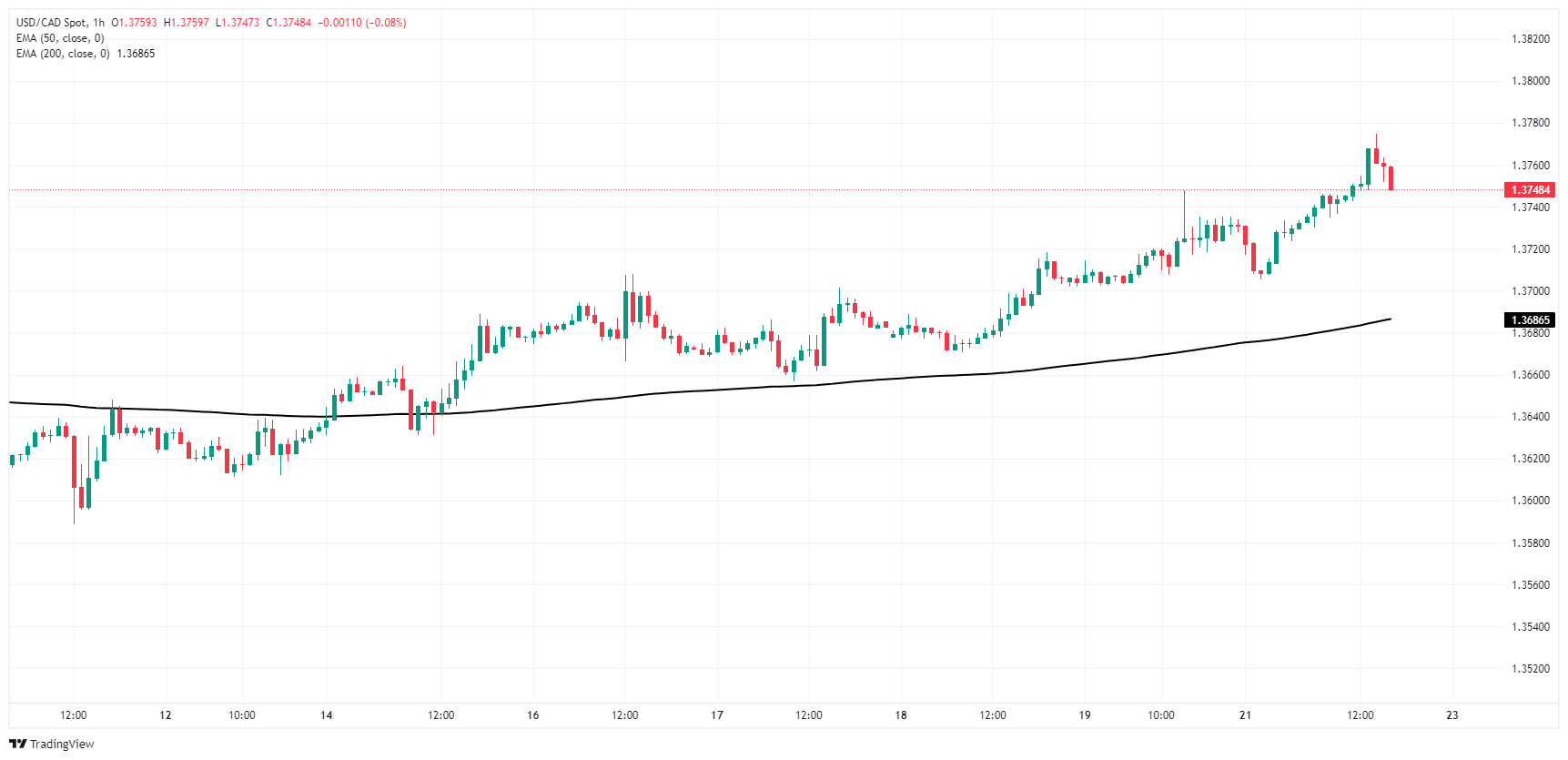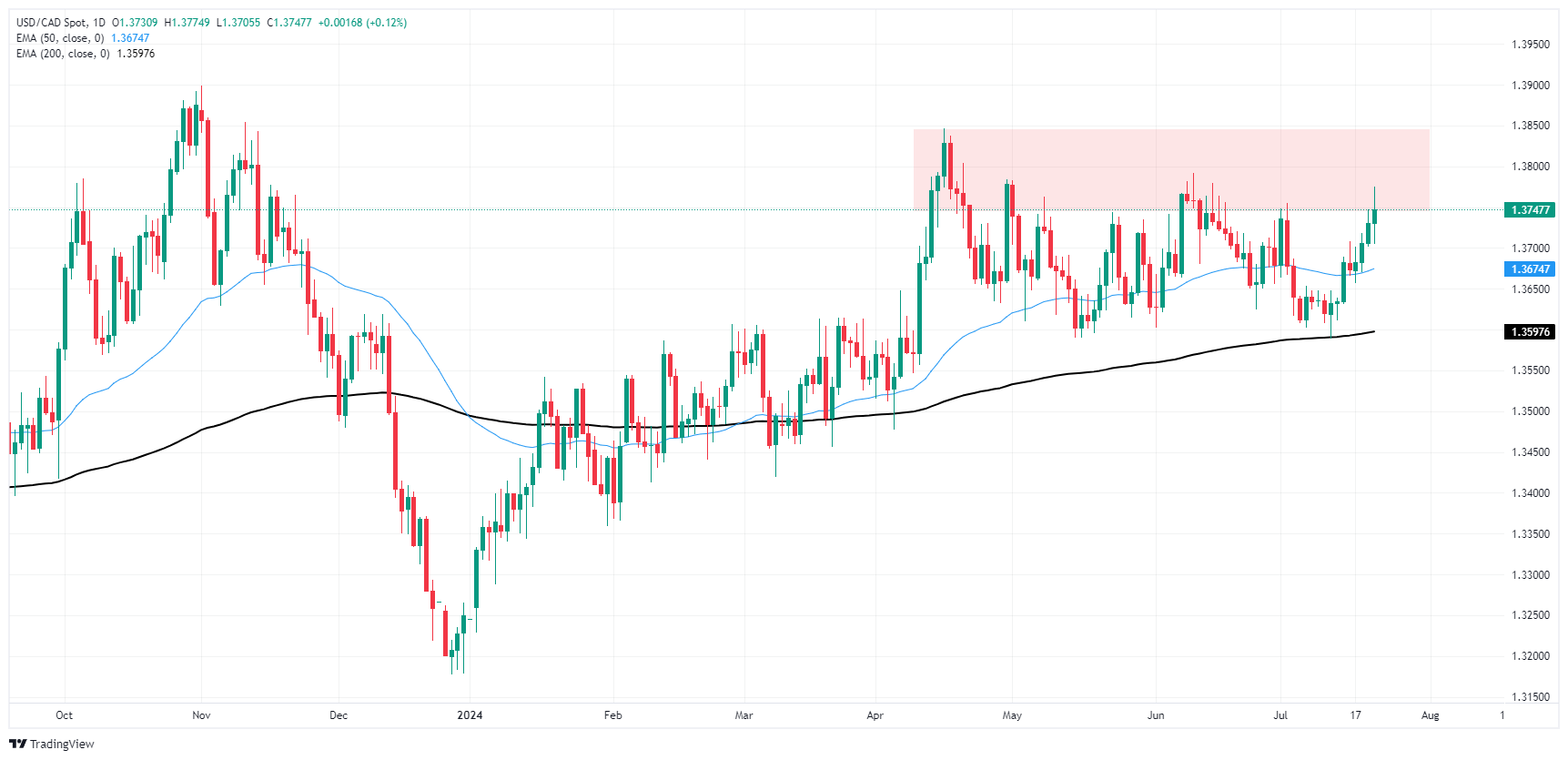- Analytics
- News and Tools
- Market News
- Canadian Dollar wobbles on Monday as CAD traders buckle down for wait to BoC
Canadian Dollar wobbles on Monday as CAD traders buckle down for wait to BoC
- The Canadian Dollar went in both directions on quiet Monday.
- Canada has another rate call looming ahead on Wednesday.
- A tepid start to the trading week leaves CAD traders to tread water.
The Canadian Dollar (CAD) went sideways on Monday, finding some gains against the Antipodeans but shedding further weight against the US Dollar. CAD traders are buckling down for the long wait to Wednesday’s rate call from the Bank of Canada (BoC), with a light economic calendar on the offer for the first half of the trading week.
The Bank of Canada is broadly expected to begin delivering a series of rate cuts this week as the Canadian central bank shrugs off a recent uptick in key inflation metrics and bends the knee to financial markets as well as housing industry advocates, an industry that accounts for an outsized proportion of the Canadian economy. Record housing prices are already crimping economic activity as Canada struggles beneath the weight of shelter and housing costs that have run well ahead of median incomes.
Daily digest market movers: BoC rate cut takes center stage for CAD traders
- The BoC is broadly expected to deliver another quarter-point cut in July after an initial cut in June.
- Markets will be tuning into BoC Governor Tiff Macklem’s Press Conference after the rate call to try and suss out how many more cuts the BoC could be poised to deliver in 2024.
- Rate markets are broadly pricing in around 65 more basis points in cuts through December.
- Market flows are tipped in favor of the Greenback on Monday, giving the USD a firm leg up.
- Key US activity and inflation figures are due later this week. After a stellar run in rate cut expectations the week before, markets could be leery heading into the release window.
Canadian Dollar PRICE Today
The table below shows the percentage change of Canadian Dollar (CAD) against listed major currencies today. Canadian Dollar was the strongest against the Australian Dollar.
| USD | EUR | GBP | JPY | CAD | AUD | NZD | CHF | |
|---|---|---|---|---|---|---|---|---|
| USD | -0.03% | -0.04% | -0.17% | 0.23% | 0.69% | 0.69% | 0.22% | |
| EUR | 0.03% | -0.01% | -0.19% | 0.21% | 0.76% | 0.67% | 0.18% | |
| GBP | 0.04% | 0.01% | -0.28% | 0.21% | 0.77% | 0.67% | 0.18% | |
| JPY | 0.17% | 0.19% | 0.28% | 0.44% | 0.94% | 0.84% | 0.34% | |
| CAD | -0.23% | -0.21% | -0.21% | -0.44% | 0.55% | 0.47% | -0.02% | |
| AUD | -0.69% | -0.76% | -0.77% | -0.94% | -0.55% | -0.09% | -0.59% | |
| NZD | -0.69% | -0.67% | -0.67% | -0.84% | -0.47% | 0.09% | -0.45% | |
| CHF | -0.22% | -0.18% | -0.18% | -0.34% | 0.02% | 0.59% | 0.45% |
The heat map shows percentage changes of major currencies against each other. The base currency is picked from the left column, while the quote currency is picked from the top row. For example, if you pick the Canadian Dollar from the left column and move along the horizontal line to the US Dollar, the percentage change displayed in the box will represent CAD (base)/USD (quote).
Technical analysis: Tepid Canadian Dollar gets buoyed by Antipodeans but losses ground against Greenback
The Canadian Dollar (CAD) was functionally rudderless on Monday, pushed around by broader market flows. The CAD gained around one-half of one percent against the Australian Dollar (AUD) and the New Zealand Dollar (NZD) as the Antipodeans fall across the board. A Monday bid in the Greenback caused CAD to shed roughly one-third of one percent against the US Dollar.
USD/CAD continues to grind its way back towards 1.3800, and the pair is on pace to close Monday in the green after an early tease towards the 1.3700 handle. The pair has closed bullish for all but one of the last seven consecutive trading days, and is set to chalk in day number eight as bidders grapple with 1.3750.
Daily candlesticks found bullish support at the 200-day Exponential Moving Average (EMA) at 1.3597 after a dip below 1.3600 in mid-July. Despite a firm bullish recovery, bidding action is running aground of a supply zone priced in just above 1.3750.
USD/CAD hourly chart
USD/CAD daily chart
Canadian Dollar FAQs
The key factors driving the Canadian Dollar (CAD) are the level of interest rates set by the Bank of Canada (BoC), the price of Oil, Canada’s largest export, the health of its economy, inflation and the Trade Balance, which is the difference between the value of Canada’s exports versus its imports. Other factors include market sentiment – whether investors are taking on more risky assets (risk-on) or seeking safe-havens (risk-off) – with risk-on being CAD-positive. As its largest trading partner, the health of the US economy is also a key factor influencing the Canadian Dollar.
The Bank of Canada (BoC) has a significant influence on the Canadian Dollar by setting the level of interest rates that banks can lend to one another. This influences the level of interest rates for everyone. The main goal of the BoC is to maintain inflation at 1-3% by adjusting interest rates up or down. Relatively higher interest rates tend to be positive for the CAD. The Bank of Canada can also use quantitative easing and tightening to influence credit conditions, with the former CAD-negative and the latter CAD-positive.
The price of Oil is a key factor impacting the value of the Canadian Dollar. Petroleum is Canada’s biggest export, so Oil price tends to have an immediate impact on the CAD value. Generally, if Oil price rises CAD also goes up, as aggregate demand for the currency increases. The opposite is the case if the price of Oil falls. Higher Oil prices also tend to result in a greater likelihood of a positive Trade Balance, which is also supportive of the CAD.
While inflation had always traditionally been thought of as a negative factor for a currency since it lowers the value of money, the opposite has actually been the case in modern times with the relaxation of cross-border capital controls. Higher inflation tends to lead central banks to put up interest rates which attracts more capital inflows from global investors seeking a lucrative place to keep their money. This increases demand for the local currency, which in Canada’s case is the Canadian Dollar.
Macroeconomic data releases gauge the health of the economy and can have an impact on the Canadian Dollar. Indicators such as GDP, Manufacturing and Services PMIs, employment, and consumer sentiment surveys can all influence the direction of the CAD. A strong economy is good for the Canadian Dollar. Not only does it attract more foreign investment but it may encourage the Bank of Canada to put up interest rates, leading to a stronger currency. If economic data is weak, however, the CAD is likely to fall.
© 2000-2025. All rights reserved.
This site is managed by Teletrade D.J. LLC 2351 LLC 2022 (Euro House, Richmond Hill Road, Kingstown, VC0100, St. Vincent and the Grenadines).
The information on this website is for informational purposes only and does not constitute any investment advice.
The company does not serve or provide services to customers who are residents of the US, Canada, Iran, The Democratic People's Republic of Korea, Yemen and FATF blacklisted countries.
Making transactions on financial markets with marginal financial instruments opens up wide possibilities and allows investors who are willing to take risks to earn high profits, carrying a potentially high risk of losses at the same time. Therefore you should responsibly approach the issue of choosing the appropriate investment strategy, taking the available resources into account, before starting trading.
Use of the information: full or partial use of materials from this website must always be referenced to TeleTrade as the source of information. Use of the materials on the Internet must be accompanied by a hyperlink to teletrade.org. Automatic import of materials and information from this website is prohibited.
Please contact our PR department if you have any questions or need assistance at pr@teletrade.global.















